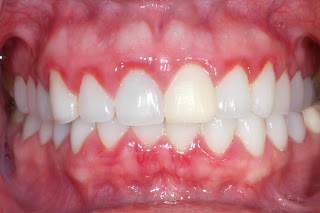Gingivitis - Let's sum up the gum problem!
Gingivitis, a common gum problem, plays hide & seek with us and only catches our attention when it gets out of control. Yes, if you aren't someone who is very cautious of your oral health, it might already be doing its evil in your mouth right now.
Scared? Don't be! Let's understand it better so we can detect it at the very beginning.
Gingiva
is a part of the periodontium, the
structure that secures the tooth in the bony socket. It is the external fleshy
tissue which drapes the alveolar bone, the part which contains the sockets for
the teeth and forms a collar surrounding each tooth. It is an important
structure as it prevents external bodies such as debris and germs from entering
the periodontium, which can cause periodontal diseases which might result in
tooth loss. Hence, to maintain healthy & strong teeth, the periodontium is
important and part of it, the gingiva is of foremost importance. When the
gingiva gets affected due to any factor, it leads to gingivitis.
The term 'gingivitis' comes from the two words, 'gingiva', which is the medical term for gums and 'itis', attached to any word indicates inflammation. Inflammation is mostly caused due to the presence of a foreign body or irritation caused due to an external factor. At times, such inflammation can also occur due to internal conditions or can be a secondary resultant of another disease. Gingivitis is a very common problem among the population and isn't very critical and hence is ignored most of the time. The matter of concern here is, gingivitis is the first stage of critical gum disease periodontitis which can lead to severe oral health issues. So, let us see how we can categorize it to understand better.
Gingivitis can be generally classified based on the duration of its occurrence as acute (small duration) or chronic (long duration), based on the number of teeth affected as localized (affecting a single tooth or some teeth in an arch) or generalized (affecting all teeth of an arch or both dental arches).
Causes :
•Causes
of gingivitis can vary but the most common cause is inability to clean the
deposition of plaque on the teeth and surrounding areas i.e. not brushing or
cleaning the teeth and mouth. The
collected plaque which contains the bacteria
leads to inflammation of the tissue.
•
Lodging of food particles or foreign bodies such as using toothpicks, pins etc.
to pick out food.
•Improper brushing techniques such as aggressive or wrong methods of brushing can lead to gingival irritation.
Risk factors associated :
•
Smoking or habit of tobacco chewing.
•
Poor oral hygiene.
•
Dry mouth - Less production of saliva or mouth breathing can result in dry
mouth.
•
Poorly fitting dental appliances, poorly finished dental restorations, crooked
teeth that are difficult to clean (maligned teeth).
•
Drugs such as phenytoin which are used for epileptic seizures, and calcium
channel blockers, used for high blood pressure and other cardiac conditions
like angina.
•
Hormonal imbalance in conditions such as pregnancy etc.
•
Genetics
• Other medical conditions like infections and altered immunity.
Symptoms :
•
A foremost and common symptom of gingivitis is bleeding gums. Bleeding from
gums while brushing is often neglected.
•
Swollen or puffy gums.
•
Bloody or reddish appearance of gums.
•
Pain while brushing and chewing or biting.
• Regressing gingival margin towards the root of the teeth.
Complications:
•
Gingivitis can be considered a mild stage of periodontitis. Periodontitis leads
to damage to the periodontal tissue which is responsible for holding the tooth
intact in the alveolar socket. If gingivitis is not treated or prevented, it
leads to periodontitis which can result in tooth loss.
•
Chronic presence of gingivitis or its recurrence can be a sign of some systemic
health complication. Underlying diseases
can show gingivitis as a secondary complication.
•
Gingivitis can be painful and lead to improper diet and hence, affecting
overall health and nutrition.
• A specific type of gingivitis called the Necrotising ulcerative gingivitis (NUG) causes painful ulcerations on the gingiva. It occurs in conditions of neglected oral hygiene, mostly in low socio-economic strata of the society.
Prevention
•Prevention
can be done by eliminating the causes. The main cause is deposition of plaque
which can be eliminated by regular cleaning and brushing. Use of additional
oral health care methods such as dental floss and mouth washes can help to
improve oral health as these can reach spaces between teeth where a toothbrush
might not be able to reach.
•
Regular visit to a dentist for dental check-up and getting a scaling procedure
done every 6 months.
•
Proper nutrition. Including raw vegetables and reducing processed & refined
food in the diet.
•
Timely self check of the mouth every month using a mirror to observe and detect
noticeable differences.
•
Avoiding insertion of objects like toothpicks and pins.
• Maintaining overall health and keeping a check of systemic health problems.
Treatment:
•Therapeutic
or surgical treatment in cases of mild gingivitis is not needed and it resolves
with prevention or elimination of cause. A proper scaling procedure done by a
professional is essential.
•
However, in cases where gingivitis can be seen progressing to periodontitis,
treatment will be needed.
•
Treatment includes scaling and root planing as needed along with necessary
medications to resolve the symptoms. Sometimes, surgical intervention is to be
done in severe cases of periodontitis.
So,
we hope now you know why you should never ignore bleeding gums. Our mouth is
the gateway for nutrition and overall health. So let's keep our gums healthy by
practicing healthy dental habits.






Comments
Post a Comment